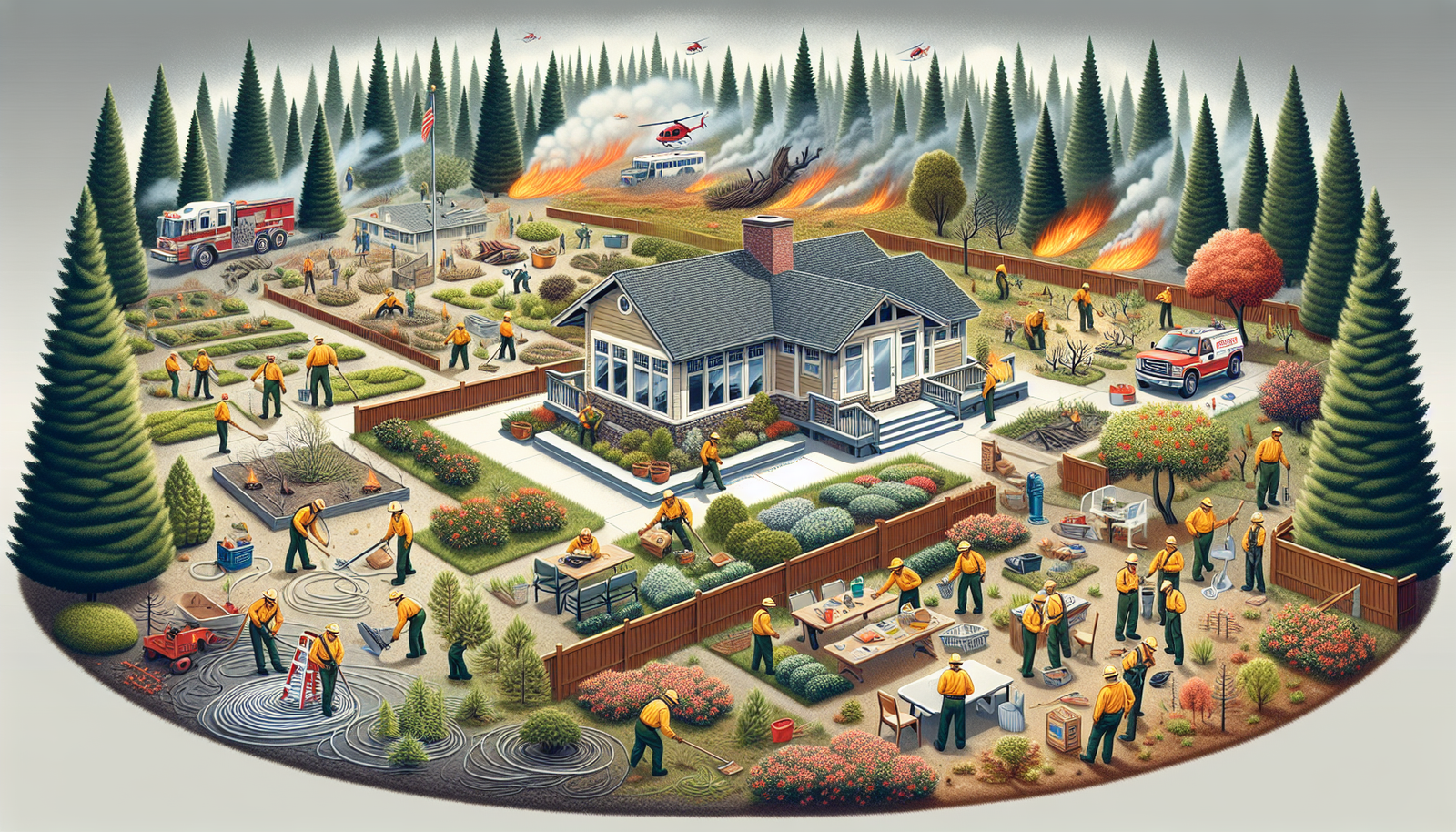The 2023 bc wildfire season escalates as an urgent crisis, ravaging ecosystems and forcing community evacuations across British Columbia. Our comprehensive coverage examines the strategies deployed for combat and resilience against this unprecedented challenge.
Key Takeaways
-
The BC Wildfire Service plays an integral role in wildfire management by employing seasonal and permanent personnel, enforcing fire prohibitions, and implementing prevention strategies with the support of contractors.
-
The 2023 wildfire season in British Columbia was the most devastating on record, marked by extreme drought conditions, thousands of lightning strikes, widespread landscape damage, and significant community displacement.
-
Effective wildfire prevention and preparedness in British Columbia hinge on initiatives like FireSmart, joint emergency management exercises, and Community Wildfire Protection Plans to reduce fire impacts and enhance community resilience.
Understanding the BC Wildfire Service

Stepping up to this formidable challenge is the BC Wildfire Service, the province’s frontline defense against the threat of wildfires. Tasked with managing wildfires on Crown lands and private properties outside of organized areas, the service is a key player in ensuring job opportunities and providing crucial statistics and geospatial data related to wildfires. With its international reputation for expert wildfire management, the BC Wildfire Service employs an annual complement of about 1,600 seasonal personnel, in addition to permanent staff consisting of safety trainers and wildfire management specialists, ready to battle the flames at a moment’s notice.
The BC Wildfire Service doesn’t just react to wildfires; it proactively works to mitigate wildfire risks. This is achieved through:
-
Enforcing open fire prohibitions and restrictions
-
Implementing a comprehensive prevention strategy that includes public education and the development of fire management plans
-
Coordinating province-wide wildfire operations through the Provincial Wildfire Coordination Centre and BC Wildfire Service Headquarters
-
Hiring contractors to support efficient and cost-effective wildfire management
The Role of the Prince George Fire Centre
Among the many entities that make up the BC Wildfire Service, the Prince George Fire Centre stands out. Situated within the largest forest region in British Columbia, it encompasses a vast area of 33.6 million hectares. This enormous expanse of land covers the central and northeast parts of the province, territories known for their rugged and remote terrains that pose unique challenges for wildfire management.
The Prince George Fire Centre’s responsibilities include:
-
Monitoring fire activity
-
Coordinating firefighting resources
-
Enforcing fire restrictions
-
Educating the public about fire safety
Each new fire season brings with it a new set of challenges, but the dedicated team at the Prince George Fire Centre remains steadfast in their commitment to protect the people and property of the region from the threat of wildfires.
Current Wildfires in British Columbia
Looking at the current wildfire situation in BC paints a sobering picture. The persistent drought has created extremely dry conditions in the Prince George Fire Centre, resulting in the ignition of two new fires. Thunderstorms in BC’s Interior have further compounded the issue, igniting hundreds of new wildfires due to a staggering 51,000 lightning strikes recorded over a seven-day period in July.
The 2023 wildfire season has caused unprecedented destruction in British Columbia, making it the most devastating in the province’s recorded history. The wildfires have had a profound impact on the region, including:
-
Ravaging the landscape
-
Displacing countless individuals and communities
-
Destroying homes and infrastructure
-
Threatening wildlife and ecosystems
-
Releasing harmful smoke and pollutants into the air
As we continue to confront the reality of these wildfires, it’s crucial to understand the role of fire centres in managing this escalating crisis.
Fire Centres Across BC
British Columbia comprises six regional fire centres:
-
Cariboo
-
Coastal
-
Kamloops
-
Northwest
-
Prince George
-
Southeast
These fire centres play a crucial role in managing wildfires across the province, each with its unique challenges and responsibilities. Most of the 93 fires listed from last season are concentrated in the Prince George region. Some of them are still burning or smoldering.
While each fire centre operates within its region, collaboration among BC’s fire centres becomes critically important when regions like Prince George are disproportionately affected by ongoing wildfires. This inter-regional cooperation is essential for the development of effective wildfire management, resilience, and recovery strategies, ensuring a coordinated and efficient wildfire response across the province.
Cooler Conditions Bring Relief

While wildfires pose a significant threat to British Columbia, relief often comes in the form of cooler conditions. Periods of cooler temperatures and rainfall in parts of the Interior and Central Okanagan have brought some respite, albeit limited due to scorched ground retaining minimal moisture. However, any amount of relief is welcome, enabling firefighters to reach beyond the surface layer of soil to more effectively extinguish fires.
The impact of cooler conditions is evident in the downgrading of two wildfires in northeast British Columbia from ‘out of control’ to ‘being held’. Approximately 450 properties in the Peace River Regional District had evacuation orders lifted, a testament to the improved wildfire conditions brought about by cooler weather. As we look ahead, the anticipation of further rainfall is expected to further stabilize regions affected by wildfires, enhancing safety and potentially allowing for the lifting of more evacuation orders.
Impact on Vancouver Island and Northern Regions
The benefits of cooler conditions extend to:
-
Vancouver Island and the northern regions of British Columbia
-
Fewer wildfire ignitions and reduced fire growth have been reported, making it easier for firefighters to manage existing fires
-
The lower temperatures and increased humidity have also made the deployment of resources to combat wildfires more effective.
This reduction in wildfire severity has led to the following benefits:
-
Certain evacuation orders have been lifted earlier, providing relief for residents of Vancouver Island and northern communities and enabling them to return home sooner.
-
The milder wildfire impact has reinforced community resilience.
-
Economic recovery for affected communities has been expedited.
Long-term Weather Predictions
While cooler conditions provide welcome relief, it’s important to keep an eye on the horizon. Climate projections indicate that British Columbia will continue to experience increased temperatures and altered precipitation patterns, both major drivers in the rise of wildfire activity. The reversal of the 20th-century wetting trend, coupled with warmer temperatures and greater moisture deficits in current climate conditions, has been a contributing factor to the increase in wildfire activity.
These projections suggest a continued increase in wildfire potential, a grim prospect for a province already grappling with increasingly severe wildfire seasons. This underlines the urgency for continued investment in wildfire management, prevention, and recovery strategies to safeguard our communities and ecosystems from future wildfire threats.
Wildfire Prevention and Preparedness

Equally important as managing ongoing wildfires is the prevention of future fires. In British Columbia, prevention and preparedness are taken very seriously, with strategies such as the FireSmart program being readily implemented. Residents are urged to be aware of wildfire conditions and follow regulations, understanding the larger socio-economic impact of increased human activity in forested areas.
The province of British Columbia has also introduced a comprehensive emergency management framework to bolster readiness for future wildfire emergencies. This framework includes a range of measures, from early detection and rapid response to recovery and rebuilding efforts post-fire.
FireSmart Initiatives
A key component of wildfire prevention and preparedness in British Columbia is the FireSmart program. This program includes a diverse range of activities designed to enhance wildfire resilience, from individual homeowners to landscape land management. FireSmart encompasses seven disciplines designed to reduce wildfire impacts on safety, property, and the environment.
Research and modelling have validated the effectiveness of FireSmart principles in reducing threats to life and property during severe wildfire conditions. The BC Wildfire Service’s Prevention Program focuses on applying these principles to mitigate the adverse effects of wildfires on:
-
public safety
-
property
-
the environment
-
the economy
Through initiatives such as the Home Ignition Zone Assessment, residents can evaluate the wildfire risk of their properties and implement recommended FireSmart practices.
Community Efforts in Mitigating Fire Risks
Communities play a crucial role in mitigating fire risks. From increasing public wildfire awareness through educational programs to organizing workshops and training sessions on fire risk reduction techniques, communities have been actively engaged in bolstering mitigation efforts.
Many communities across BC have developed Community Wildfire Protection Plans, tailored to address the specific risks and needs of their locality. These plans include measures such as creating defensible space around properties and implementing fuel management projects. Joint emergency management exercises between communities and local fire services have also been essential in preparing for potential wildfire events. Collaboration efforts have extended to forming partnerships with Indigenous groups who contribute traditional fire management practices to local strategies.
The Ecological Impact of Wildfires

As we navigate the complexities of wildfires, it’s crucial to consider their ecological impact. Climate change has led to drier and hotter summers in British Columbia, extending the wildfire season and increasing the susceptibility of the landscape to these events. Persisting trends of elevated temperatures and lower humidity are expected to continue, contributing to the heightened risk and intensity of wildfire activity.
British Columbia’s diverse ecosystems, such as temperate rainforests and high-desert woodlands, exhibit different responses to wildfire exposure due to the province’s varied climates and fire regimes. Cultural and prescribed fires are effective land stewardship tools used in British Columbia to reduce the impact of natural wildfires.
Forests at Risk
Different forest zones within British Columbia face varying wildfire risks and regimes. The Central zone has historically experienced mixed-severity wildfires, but recent conditions and pine beetle epidemics have led to an increase in fire activity. In the Coastal zone, traditionally known for infrequent fires, rising climatic moisture deficits signal a shifting paradigm towards increased wildfire risk, particularly concerning for old-growth forests.
The Northern zone underwent its most active wildfire season in 2023, characterized by large, high-intensity fires that significantly expanded the area burned. These trends underline the urgent need for effective year round wildfire management strategies to protect these diverse forest ecosystems.
Smoke and Air Quality Concerns
The ecological impact of wildfires extends beyond the destruction of forests. Dense smoke from intense wildfire activity can severely compromise air quality, presenting health risks to humans and animals in the region. Prolonged exposure to wildfire smoke can lead to a range of health issues, from respiratory problems to exacerbation of pre-existing medical conditions.
To protect residents from wildfire smoke exposure, British Columbia offers resources and disaster psychosocial support teams for mental health assistance. These resources provide crucial information and support to those affected, reinforcing the importance of preparedness and recovery measures in the face of wildfire threats.
Recovery and Rebuilding After Evacuation

Recovery and rebuilding after a wildfire event is a critical phase that involves more than just extinguishing the last embers. It’s a phase that requires comprehensive support and resources, including:
-
Assistance information
-
Evacuation details
-
Pet and livestock care
-
Insurance
-
Health resources
-
Regional emergency links
Emergency Support Services in British Columbia offer crucial assistance such as food, accommodation, clothing, health services, pet care, and transportation to those evacuated during wildfires.
Community resiliency centres serve evacuees by bridging the gap between response and recovery phases with support and information from various agencies. Even as evacuees from areas like northeast BC find refuge as far away as Prince George and Chetwynd, wildfire recovery considers the social, economic, and environmental impacts.
Economic and Social Recovery Programs
Economic and social recovery programs play a vital role in helping affected communities bounce back post-wildfire. The BC Economic Development Association (BCEDA) offers tools such as the Economic Recovery & Resiliency Manual to guide communities in economic recovery following disasters like wildfires. BCEDA established Canada’s first Economic Disaster Recovery Program to bolster the resiliency and recovery of economies post-crisis.
The BCEDA provides critical services in economic recovery, including emergency access to BC BusinessCounts for local governments and resources for managing economic recovery after emergencies. Additionally, there are funding programs available in British Columbia to support community-driven wildfire prevention initiatives as part of the social and economic recovery process.
Environmental Restoration Efforts
Environmental restoration is another crucial aspect of post-wildfire recovery. The Nature Trust of British Columbia has initiated comprehensive restoration efforts for the Cherry Creek Conservation Area, focusing on activities like re-seeding with native grasses and managing potential rain event impacts on burnt landscapes.
Post-fire recovery at Cherry Creek includes:
-
Replacing damaged fences
-
Felling trees that pose a danger
-
Hand-seeding to prevent the spread of invasive plants
-
Aerial seeding of fireguards to prepare for winter
Effective wildfire recovery necessitates an ongoing commitment, including replacing conservation equipment and securing fencing to protect sensitive ecosystems after a wildfire.
Wildfire Season Analysis: A Retrospective
As we reflect on the 2023 wildfire season, we gain insights into the scale and magnitude of the challenge faced by BC. It has been one of the most severe seasons, with record-breaking areas burned, marking a significant increase in wildfire activity since the mid-2000s. Almost 25,000 square kilometers of land were burned in the 2023 wildfires, highlighting the extensive damage to the province’s landscapes.
There were a total of 2,217 fires detected throughout the 2023 wildfire season in British Columbia. The cost of fighting these wildfires amounted to approximately $770 million, a sobering figure that underscores the economic impact of these devastating events.
Month-by-Month Breakdown
A month-by-month breakdown of the 2023 wildfire season provides a closer look at how the situation escalated over time. The season started with fewer incidents than usual but grew in intensity with the onset of summer. In July, lightning strikes triggered over 150 new wildfires, marking a significant escalation in wildfire activity for the region.
August witnessed the emergence of several massive wildfires, including one that exceeded 20,000 hectares, leading to substantial evacuations and property damage. By September, the combination of firefighting efforts and weather changes led to the containment of the most destructive fires of the season.
Lessons Learned and Future Outlook
The 2023 wildfire season holds valuable lessons for future wildfire management. Adaptive management practices have proved crucial in addressing the unpredictable nature of wildfire events, accommodating learning and iterative adjustments to strategies in real-time. Real-world data and outcomes from the wildfire season have informed adjustments to future mitigation and response strategies, illustrating the dynamic nature of wildfire management.
Community education programs about wildfire risks and preparedness measures, including the FireSmart program, facilitated better community resilience against wildfire threats. Increased public awareness and participation in preventive measures have contributed to a decrease in human-caused wildfires, emphasizing the effectiveness of comprehensive community engagement. Investments in satellite technology and improved firefighting equipment have played a pivotal role in enhancing detection and suppression capabilities, thus, minimizing wildfire damages.
Summary
As we navigate through the increasingly severe wildfire seasons in British Columbia, it’s clear that resilience, recovery, and preparedness strategies are not just important, they are essential. From the valiant efforts of the BC Wildfire Service and the Prince George Fire Centre to the comprehensive preventive measures of the FireSmart program and community-led initiatives, we see a province determined to face this challenge head-on.
However, as we look to the future, it is clear that the threat of wildfires is not going away. With climate projections indicating a continued increase in wildfire potential, it’s crucial that we remain vigilant, stay informed, and be prepared. The fight against wildfires is not one that can be won in a single season. It requires a sustained commitment, a proactive approach, and the collective effort of all residents of British Columbia.
Frequently Asked Questions
What is the role of the BC Wildfire Service?
The BC Wildfire Service manages wildfires, provides job opportunities, crucial statistics and geospatial data, enforces fire restrictions, and educates on prevention strategies.
How does the FireSmart program contribute to wildfire prevention and preparedness?
The FireSmart program contributes to wildfire prevention and preparedness by engaging in activities that enhance wildfire resilience and reduce impacts on safety, property, and the environment. This includes seven disciplines aimed at mitigating the effects of wildfires.
What is the impact of climate change on wildfires in BC?
Climate change has caused drier and hotter summers in British Columbia, leading to an extended wildfire season and heightened landscape vulnerability. This has significantly impacted the frequency and severity of wildfires in the region.
What are the recovery and rebuilding efforts after wildfires?
After a wildfire, recovery and rebuilding efforts involve updated programs and resources to support affected communities with evacuation details, pet and livestock care, insurance, health resources, and regional emergency links. This helps in the process of rebuilding and recovery.
What were the key takeaways from the 2023 wildfire season?
The 2023 wildfire season highlighted the critical need for adaptive management, community engagement, and technological investments to build future resilience against severe wildfires.






